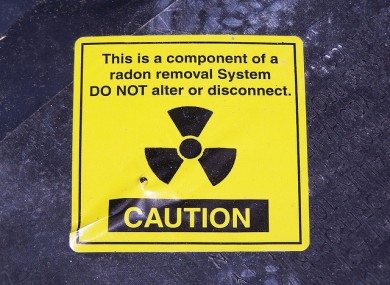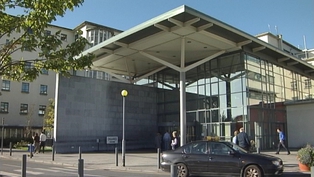Ireland has ‘very significant high levels of radon’
by Deborah Condon of www.irishhealth.com]

Over 300 homes recorded high levels of the cancer causing gas, radon, between June and December of last year, new figures have shown.
Radon, a naturally occurring radioactive gas present in all rocks and soils, is classified as a class A carcinogen by the International Agency for Research on Cancer. When it surfaces in the open air, it is quickly diluted to harmless concentrations. However, when it enters an enclosed space, such as a house, it can sometimes build up to high concentrations, leading to an ‘unacceptable health risk’.
After smoking, long-term exposure to radon gas in the home is the greatest single cause of lung cancer in Ireland. The gas is linked to up to 200 cancer deaths here every year.
According to the latest figures from the Radiological Protection Institute of Ireland (RPII), over 2,500 people tested their homes for the gas between June 1 and December 31, 2011. Of these, 321 recorded high levels, with one home in Galway recording a level that was 18 times higher than the current acceptable limit of 200 becquerels per cubic metre (Bq/m3). It had a radon concentration of 3,700Bq/m3.
Another four homes were found to have radon levels of over 2,000Bq/m3, which is 10 times higher than the acceptable level. These homes were located in Galway, Sligo and two in Kerry.
Meanwhile, 24 homes were found to have radon levels that were between four and 10 times higher than the acceptable limit. While these were located all over the country, the highest number was found in Galway (six) and Waterford (also six).
“Our research shows that Ireland has a significant radon problem. Exposure to high radon levels causes lung cancer and many families are unknowingly living with a high risk to their health,” commented RPII senior scientist, David Fenton.
He emphasised the importance of testing your home for radon, ‘as this is the only way of knowing if the occupants of the home are exposed to this cancer-causing gas’.
Mr Fenton also noted that if high levels are found, reducing them ‘is easy to do’.
In order to test for radon, a special detector is put in a bedroom and a second one in a living room for a three-month period.
These detectors are sent to the homes and back to the RPII by post where they are analysed. The cost of a measurement is around €50.
A 19 year old Lady driver dies after a single-vehicle road accident in Galway
The Gardaí in Galway are today investigating the circumstances of a fatal single-vehicle road accident in Galway city this morning.
The collision occurred at approximately 3.30am on the Seamus Quirke Road.
The three occupants of the car were taken to Galway University Hospital, where the driver, a 19-year-old-female, was pronounced dead.
The two other occupants, a 21-year-old male and an 18-year-old female are being treated for their injuries at Galway University Hospital.
The road is closed to facilitate a forensic collision examination and diversions are in place.
Witnesses or anyone with information is asked to contact the gardaí in Mill Street Garda station on 091 538000, the Garda Confidential Line on 1800 666 111 or any Garda station.
New plans in discussion
For an all-Ireland minimum alcohol price
Health Minister Edwin Poots above attended the meeting along with the Irish Republic’s Health Minister Dr James Reilly and Minister of State for Health Roisin Shorthall shown above.
Health authorities have decided upon a cross-border strategy on a minimum price for alcohol.
The proposals were outlined at the first formal North/South conference on alcohol misuse, held in Armagh on Thursday.
Health Minister Edwin Poots was joined by the Irish Republic’s Health Minister Dr James Reilly and Minister of State for Health Roisin Shortall.
They said they hoped to agree a minimum drink price before December 2012.
Mr Poots said alcohol misuse was one of the main threats to public health in the province.
“Research has shown that it costs Northern Ireland up to £900m every year, and almost £250m of these costs are borne by the health and social care sector,” he said.
“If we do not take significant and robust action, the costs to Northern Ireland, and the health and social care system in particular, will continue to grow.”
He said there was a need to co-ordinate the introduction of the proposed new measures.
“We want to make sure we don’t have a disparity where alcohol is one price north of the border and considerably more expensive south of the border, or vice versa,” he added.
Facts from the Department of Health
- Alcohol is Northern Ireland’s favourite drug.
- In Northern Ireland, more than seven out of 10 adults drink alcohol.
- A recent survey indicated that 9% of those who drink are likely to have a problem with alcohol.
- In 2010, 284 people died directly as a result of alcohol misuse, an increase of around 40% since 2001.
- In 2010/11 there were over 12,000 admissions to acute hospital with an alcohol related diagnosis.
Ms Shortall told the Irish Times that both administations were closely monitoring the Scottish National Party’s plan to introduce a minimum charge which is considering charging 45-50 pence per unit of alcohol.
This would mean that a bottle of cider with 14 units of alcohol, which currently costs £2.30, would be increased to £7.
In November, the Scottish government made a second bid to bring in legislation which would set a minimum price for a unit of alcohol.
It has already put in place a ban on “irresponsible” drinks promotions.
Reduce cheap alcohol availability
Dr Reilly said the conference had set the scene for an all-island collaborative approach for tackling issues relating to alcohol abuse.
“The areas we would like progress on a North/South basis are measures to reduce the availability of cheap alcohol and treatment and rehabilitation of those affected by alcohol misuse,” he said.
“Alcohol use and misuse is an area where both jurisdictions can achieve a lot together – especially in dealing with the challenges that alcohol presents for young adults.”
He highlighted the costs alcohol had on the Republic of Ireland, claiming 2,000 beds were occupied every night in Irish acute hospitals due to alcohol associated problems.
Mr Poots said research has shown that it costs Northern Ireland up to £900 million every year. He added that it cost the healthcare system 1.2bn euros.
The conference brought together the policymakers and agencies from both both sides of the border for the first time to explore some of the common problems caused by alcohol.
Other speakers included Prof Sir Ian Gilmore, chairman of the UK Alcohol Health Alliance and also the European Alcohol and Health Forum Science Group; Dr Peter Anderson, an international public health consultant; and researcher Dr Fiona Measham.
Prof Gilmore welcomed this cross-border initiative.
“The health harms we are seeing in both the UK and Ireland are so great that we urgently need effective coalitions between partners such as this,” he said.
“These allow mutual learning and the development of shared objectives.”


No comments:
Post a Comment